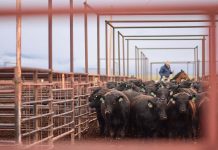Psst…do you want to know a secret?
Kids aren’t very good at keeping them.
Yup, that’s usually how long the mystery remains with nearly every birthday present purchased for a sibling or every “don’t tell your dad I let you” moment. I have four little ones, so it’s hard for a secret to remain that way for long at our house.
But kids aren’t the only the demographic to fit that description, and that’s not necessarily a bad thing.
Unique ideas
When I meet ranchers doing something unique, who have good things going, they’re always willing to share. They spill their trade secrets and are eager to help others learn what they’ve learned without the same investment of trial and error.
Cattlemen’s meetings feature guys and gals who have made adjustments to their calving season or weaning calendars, people who graze cattle differently than the previous generation or those who have found profitable marketing methods by bucking the trend.
Droughts
When Oklahoma rancher Joe Mayer spoke at the Range Beef Cow Symposium last year he shared his step-by-step methodology on how to come out of an unforgiving drought with a better herd than you had prior.
He talked about his use of herd records, feeding and carcass data, and even commercial DNA tests.
“It shows me that we need to use the best tools available to select breeding animals that will produce better-performing cattle with better carcass quality,” Mayer said.
I’d be surprised if the attendees didn’t pick up ideas that they could take home to their own operations.
Carcass data
Producers often call us when they get carcass data back, anxious to talk about what went right and how to build on that. On-line communities are often abuzz with this same kind of “look what worked” talk.
This spirit of sharing I’ve found in the cattle business isn’t restricted by size or type of operation either. Last summer I visited one of the world’s largest cattle feeders when I stopped by a yard in the JBS Five Rivers cattle feeding group in Colorado.
“We’ve had no secrets about this program,” said Nolan Stone, general manager of Kuner Feedlot. They were beta-testing a program to fill pen space and help deliver high-quality genetics to an industry soon looking to rebuild.
“We’ve told people our goal is not to just market these 1,100 heifers, because that’s not much in the whole scheme of things. We’d like to tell people ‘here’s how we did it’ and hopefully others will do it and make better cattle,” he said.
New concept
They were trying a new concept, and then documented the steps so any feeder, of any size, could copy it. Never mind that cattle numbers are short, and anyone bidding on the same cattle they want is competition. Joe Mayer didn’t hold out on information, hopeful that his cattle would remain in an elite group where 70% or more hit premium Choice. As they got better, they wanted others to follow. This isn’t unique to these two examples.
“A rising tide floats all boats,” I often hear people say.
Competition
I know that hasn’t always been the attitude, but as competition for land, feed and cattle continues, it’s nice to know that the beef business succeeds where secrets give way to sharing.
Next time in Black Ink® Steve Suther will consider “the home stretch.”












